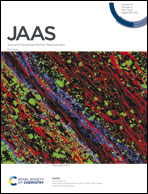An evaluation of M2+ interference correction approaches associated with As and Se in ICP-MS using a multi-day dataset along with ICP-MS/MS/HR-ICP-MS based analysis and hierarchical modeling as a means of assessing bias in fortified drinking waters and single component matrices†‡
Abstract
Three ½ mass oriented rare earth element (REE) M2+ correction approaches (fixed factor, a dual internal standard, and an in-sample) are evaluated for use in an ICP-MS environmental method update. The multi-variant-based evaluation includes analyzing the same 19 REE-fortified matrices on eight different days over a two-month period using two instrument tunes. These REE-fortified matrices were also analyzed using HR-ICP-MS and ICP-MS/MS to estimate the reference value for use in the principal component analysis (PCA) and hierarchical modeling evaluation. A fixed factor is unable to compensate for matrix and mass dependent drift and because of this it generates the largest across matrix, tune, and day 95th percent confidence bounds for the REE corrections on both As (1.1 ppb) and Se (23 ppb) using samples fortified with 100 ppb Nd, Sm & Gd. The PCA analysis indicated that M2+ ions cluster together across matrix, tune and day better than M1+ and these tighter correlations are reflected in reduced 95th percentile confidence bounds for dual M2+ internal standards (M2+; As = 0.3 ppb; Se = 5.4 ppb; n = 704) relative to M1+ internal standards (M1+; As = 0.6 ppb; Se = 12.0 ppb; n = 1056). The use of an in-sample M2+ correction produced comparable 95th percent confidence bounds (As = 0.2 ppb; Se = 3.4 ppb; n = 352) relative to the M2+ internal standard approaches. Finally, the hierarchical modeling indicated M2+ ions as internal standards tend to minimize the across day variability induced by cone changes and the daily reoccurring matrix shifts in the M2+/M1+ ratio associated with 250 ppm matrices of Na, Ca, and Mg. This internal standard driven reduction in variability can be beneficial in compliance monitoring methods.



 Please wait while we load your content...
Please wait while we load your content...